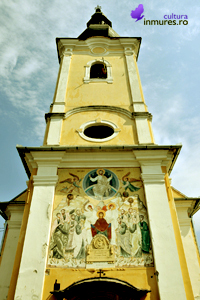
The Stone Church
The political context in Transylvania at the beginning of the 18th century proved to be favorable to the Romanian population that had been considered a tolerated nation until that time, was not granted the same rights as the other nationalities and its religion was not recognized as official. As soon as the Hapsburg Empire extended toward East by occupying Transylvania, it became obvious that to convert Romanian Orthodox believers to the Catholic religion represented a great political potential. This would have constituted a countermeasure to the strong opposition of reformed Hungarian noblemen toward the Viennese Court, by numerically balancing Catholics and Protestants. Thus, the so-called “process of unification” of some Orthodox believers with the Catholic Church occured at the beginning of the 18th century. Following their separation from the bishoprics of the Romanian countries and their becoming subjects to the papacy, the newly Greek-Catholic believers were granted certain privileges, among which was permission from the central authorities to build churches and parish houses. Until mid-18 century, the Romanian community of Tîrgu-Mureș had not had its own church, thus having to travel for long distances to neighboring towns where such places of worship existed. The first Romanian churches erected in Tîrgu-Mureș are the Stone Church and the Wooden Church, placed next to each other, at 9 and 13 Metropolitan Andrei Saguna Street. In 1750 Romanians were given a plot of land due to the interventions of Jesuit monk Iosif Balogh at the Town Council. Trader Andrei Grecu would build a wooden church on this land, on his own expense, which was used, at first, by all Romanians in the city, as there was no clear distinction between “united” (Greek-Catholic) and “not united” (Orthodox) Romanians at that time in Tîrgu-Mureș. Soon, the situation would change as Orthodox Romanians were prohibited to enter the newly-built church. The fact that a Greek-Catholic Arch-Priest”™s Office was established in Tîrgu-Mureș is proof of the city”™s growing importance as center of the new faith. Ioan Bob, future Bishop of Blaj, served as arch-priest between 1779 and 1782. It was not by chance that in 1792, after the old church had burned down, Ion Bob would provide the necessary material support to build a brick church, thus becoming the founder of the church currently known as the Stone Church of Tîrgu-Mureș, as proven by the inscription above the door. The works went on from 1793 until 1794, under the supervision of Topler János. The plan is simple, with a square tower on the West wing, a spacious rectangular nave and the semi-circular apse of the altar. The nave is covered by an archway reinforced with double arcs, whereas for the apse a semi-cap was the architect”™s choice. The walls are delimited by pilasters with ionic caps next to more conspicuous brick masses that support the arcs. The tower with the bulb-shaped roof is an expression of Transylvanian Baroque art, applied to Romanian churches. Other decorative elements are the pilasters in the corners, the cornice underneath the tower roof, the ovoid shapes of the stucco and the framing of the windows with semi-circular openings, marked by lighter-colored plaster. Above the entrance lies a plaque with a relieved coat-of-arms of the city, decorated with a wreath and containing an inscription that certifies Ion Bob”™s capacity as founder of the church. Bibliography: Pompiliu Teodor, Secolul luminilor în țările române în vol. Istoria României , ed. Corint, București, 2002, pp. 241-243. Ioan Eugen Man, Tîrgu-Mureș, istorie urbană de la începuturi pâní£ în 1850,Tîrgu-Mureș, Ed. Nico, 2006, pp. 211-212. Traian Popa, Monografia orașului Târgu Mureș, Tîrgu-Mureș, Cultural Foundation"Vasile Netea",2005 (first edition 1932), pp. 224-228.

